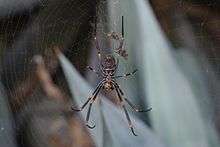Trichonephila plumipes
Trichonephila plumipes is a species of spider found in Australia, Indonesia and some Pacific Islands, which exhibits extreme sexual dimorphism. It is sometimes called the tiger spider due to its markings which look similar to a tiger. This species has historically been confused with Nephila clavipes, with the main distinguishing visual difference being significantly smaller black hair tufts on the legs. As with other spiders from the genus Nephila, they have a distinctive golden web.
| Trichonephila plumipes | |
|---|---|
 | |
| Female eating a ladybird, with male in attendance | |
| Scientific classification | |
| Kingdom: | Animalia |
| Phylum: | Arthropoda |
| Subphylum: | Chelicerata |
| Class: | Arachnida |
| Order: | Araneae |
| Infraorder: | Araneomorphae |
| Family: | Araneidae |
| Genus: | Trichonephila |
| Species: | T. plumipes |
| Binomial name | |
| Trichonephila plumipes | |
| Synonyms | |
| |
Studies have shown that orb-weaving spiders grow bigger and can produce more eggs in highly urbanised places due to more food being available, warmer temperatures, fewer predators such as birds, and no pesticide chemicals. These spiders are commonly found in both urban and natural landscapes.[2]
References
- "Taxon details Trichonephila plumipes (Latreille, 1804)". World Spider Catalog. Natural History Museum Bern. Retrieved 2020-07-14.
- Australian Geographic (August 2014). "Spiders in the city are bigger".
External links
| Wikimedia Commons has media related to Nephila plumipes. |



.jpg)